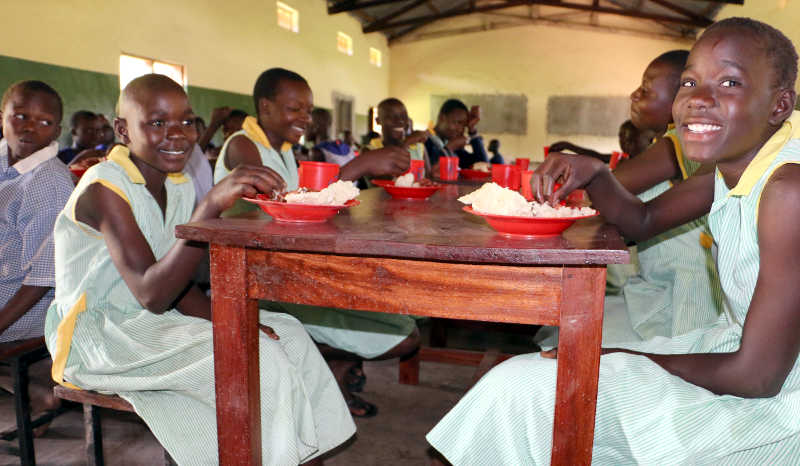Guest Writer
Why gov’t needs to play a bigger role in school feeding now than ever before

WFP’s is implementing a school feeding programme in Karamoja
During her address to the nation on the achievements of the National Resistance Movement (NRM), in the past four years, in the education sector, the Minister of Education and Sports (MoE&S), Janet Museveni, reminded parents of their responsibility to feed their children, especially, while at school.
On, May 9, 2018, New Vision ran a story, “Parents’ Reluctance Retards School Feeding Policy.” Two days later, the same paper published a story titled: “Sensitise Parents on School Feeding, First Lady Urges Leaders.”
However, studies available, indicate that the opposite is happening in most schools. In fact, based on the information available, one can pose the following questions. First, must parents’ be blamed entirely for failing to feed their children with the findings of the Uganda National Household Survey (UNHS), 2016/17 reporting a poverty rate of 21.4% up from 19.7% in 2012/13?
Secondly, is it really realistic for anyone to reprimand parents’ for failing to take care of the nutrition needs of their children? Don’t you think it is necessary for government to render a helping hand, in as far as feeding needy children is concerned?
Are people in the most developed countries (MDCs) getting enough food? Move on along with me in trying to find the most ideal matches for this puzzle.
The First Lady and Education Minister, Janet Museveni, has initially been traversing the country, mobilising parents and communities on the importance of school feeding. “I have decided to launch a countrywide nutrition and school feeding campaign to mobilise parents and remind them of their cardinal responsibility of feeding their children, a role they had forgotten, or ignored, or perhaps did not know,” said the Minister.
In fact, in 2018, the minister reminded parents that the law will take its course, should they turn down her plea. Promotion of school feeding and nutrition is an ideal move taken by the minister in particular, and the Education Ministry in general, of course on behalf of government, and I would really wish to applaud her, and the entire team for taking this direction.
However, prior to extending the long arm of the law on “deviant” parents, I wish to diligently request the Minister, and her team to study the findings included in this brief.
The constant here is, “schools are full of hungry children who are not learning”. So, if this is the case, “Why don’t we feed them?” As with any public policy, the case for school feeding rests entirely on its affordability, effectiveness, and a dimension that is specifically acute in those fragile states-its feasibility.
Indeed, beyond its effectiveness, a potential selling point of school feeding is its feasibility. Abysmal levels of learning and chronically absent teachers highlight that several of the low-income countries simply can hardly deliver basic education to the bulk of their populations.
Experiences from India and Mozambique, suggests that even countries in the developing world-sometimes with the help of donor aid, can successfully deliver meals to millions and millions of their children.
Taking a closer look at India’s massive school programme, Abhijeet Singh notes: “Midday meals, which reach about 120 million children on each school day, are probably the most successful of all interventions in education that the Indian government has delivered in the past decade.
On any school day, at least, a quarter of the teachers are absent from public schools, only 45% of those in school are teaching, but in 87% of schools, a hot meal is served.
Similar school attendance levels have been recorded in Karamoja, even though the school-feeding programme there is entirely funded by donor money.
Related articles
WFP uses homegrown school feeding programme to score many human development goals in Karamoja
But with India and Mozambique, there is evidence to conclude that national governments, might do more good for children, once they decide to relocate funds away from some current activities that are ranked high on the global development agenda in education-including laptops, construction of new classroom blocks, and even (gasp) raising salaries and allowances for teachers-so as to feed children in school.
According to findings by the United Nations World Food Programme (WFP), in 2018, a total of 66 million primary school age children go hungry each day, with 23 million hungry children in Africa alone.
In addition, 75 million school-age children (55% of them girls), do not attend school, with 47% of them now residing in sub-Saharan Africa. To this end, the need to check on hunger while boosting school enrolment among these children is evident, and for this reason, school feeding programmes have been developed world-wide to deal with this multifaceted global challenge.
The World Bank defines school feeding programmes (SFPs) as, “those targeted social safety nets that provide both educational and health benefits to the most vulnerable children, thereby increasing enrolment rates, reducing absenteeism, and also improving food security at the household level.”
There are two main ways through which food can be distributed through school feeding programmes: On-site meals and take-home rations. On-site meals might include a bowl of porridge, or nutrient fortified crackers served to children while at school, during morning and afternoon meal and snack times. By contrast, take-home rations (THRs) relate to a collection of basic food items, such as maize flour, rice, beans, and so forth, which may be sent home and transferred to the families of children who attend school regularly.
Arguably, meeting all children’s nutritional needs bolsters learning, positively impacts on children’s health, well-being, and also encourages many to attend school. In fact, once children are malnourished during their childhood, the impact can last a life-time. Hunger among children has long-term adverse effects on their health. Ideally, this partly explains the reason why, I am strongly advocating for the establishment of a national feeding programme for schools in Uganda.
Poor nutrition especially among children greatly reduces cognitive abilities, stunts their growth and thereby undermines the learning ability.
In 2006, it was found that, one in four seven-year olds had not yet started school, even with the Universal Primary Education (UPE), already in place. In school, today, and right now, in Kenya, Sierra Leone, Ghana, and Uganda, as well, children are struggling through the school day, since all they have today, is a bowl of watery maize porridge.
This is simply, an opportunity to education, but not an equal opportunity.
Admittedly, this is one of the big array of drawbacks encountered by children, if they miss out on meals. Malnutrition impairs the children’s physical development and mental ability. Evidence shows that malnourished children are 20% less likely to be able to read as an adult, and earn less than their peers over their lifetime.
Speaking at the Global Nutrition Summit held by G8 on June 28, 2013, Jasmine Whitebread, Save the Children International Chief Executive, said, “Poor nutrition is driving a literacy and numeracy crisis in developing countries, and is also a huge barrier to further progress in tackling deaths.” Even though the United States (U.S.) is bountiful and the world’s largest individual exporter of food, millions of Americans, actually are not.
According to data released by the U.S. Department of Agriculture, in 2018, almost 6% of households-about 18 million people-were consistently not getting food to eat. And yet, another 8%, 3 million people, had occasional problems feeding themselves. Altogether, about 14% of the U.S. households, roughly 48 million people, or one in seven Americans-go hungry at some point during the year, and not simply because they are trying to lose weight, but because of food insecurity, or hunger.
Jeffrey Cohen of the Ohio State University of Canada, says that one in six Canadian children lives in a household to poor to put nutritious food on the table. “Fewer than one in 10 Canadian children and youths are eating the amount of fruits and vegetables recommended for healthy development. Referred to as “food insecurity,” insufficient access to affordable and nutritious foods is a problem that is on the rise across Canada.
According to a study carried out by the World Food Programme (WFP) and African Union experts in 2013, “children not eating well costs Uganda more than 5% of her national income, the first large-scale survey of the economic impact of malnutrition shows.”
The report further indicates that poor early years feeding-whether through not enough food, or more, often, a monotonous, vitamin-poor diet- has led to a decline in Gross Domestic Product (GDP) by 5.6%. “Some of the most commonly eaten food in Uganda, such as matoke (got from plantains) and posho (produced from maize), are poor in vitamins.
According to findings by Peril of Africa (2017), it has been reported that most of Uganda’s children are going to school hungry, and 29% of those aged under five (5), are stunted due to poor feeding. Nearly half of all the country’s populations overall, meanwhile, consume less calories than they require each day.
A survey conducted by the National Planning Authority (NPA), with support from WFP, in the last decade, asserts that Ugandans consume an average of 1,860 kilocalories per person each day, compared to the minimum daily requirement of 2,200 kilocalories. People largely depend on staple carbohydrates for calories, yet these staples are not produced in the required amounts.
According to Dr. Kisamba Mugerwa, formerly Chairperson of NPA, a large majority of school children enter class on an empty stomach, and only one in three children gets to eat a meal at school. The survey conducted by Sauti za Wananchi, or Voices of the Citizens Survey (VoCS), in 2015, indicates that poverty and food insecurity are the major problems that Ugandan households are facing in the country.
According to findings by the survey, 7 out of 10 persons said they had to skip a meal due to lack of food; 69% said their households ran short of food, while 67% said they were hungry, but had nothing to feed on, and 85% were scared about running short of food in the next three months.
Sauti za Wananchi’s officer Mary Nyanzi, and the lead researcher, says that the findings reveal that Ugandans were not happy with their state of being.
Sauti’s revelations are not far-fetched, for it is supported by Dr. Mary Nakabugo, the Executive Director of Twaweza Uganda, who argues that the findings show that government ought to step in and offer its support.
“Ordinary Ugandans are working very hard to provide for themselves and their children, but they are struggling to achieve economic security. The government can step in, to support their efforts, and ensure that no one is left behind, as the country forges ahead,” she says. In fact, the United Nations International Children’s Emergency Fund’s (UNICEF’s) current nutrition plan for Uganda states the evidence to a co-relationship between nutrition and educational achievement.
Provision of food for consumption at school can help to relieve immediate short-term hunger which is highly beneficial for learning. By alleviating short-term hunger amongst children at school, improvement in performance in school tests is realised, thereby promoting normal progression from grade to grade, in completing one’s level of basic education.
The Addis-Ababa Education For All Declaration (AEFAD), held between 23-25, February, 2010, pointed out: “We call upon Education For All partners to build inclusive education systems and intensify efforts to support initiatives targeted at the most marginalised, including social protection measures such as transfers and scholarships, community involvement, and multi-sectoral approaches such as school feeding and early childhood development programmes.”
According to Josette Sheeran, executive director WFP, school “lunches”, are the most cost-effective, and powerful tool in the world, in as far as empowering girls’ human rights, is concerned. “When we feed a girl, we help empower a family, a village, and a nation,” says Sheeran.
Vincent Winstone Ghambi, formerly Malawi’s Deputy Education Minister, has this to say about school feeding programmes: “The programme surely motivates children to go to school. You see children everywhere with their cups. They tie them to their shirts and you just know that it is important to them. They might forget anything at home, but never their cups! We have seen cases where children fight their parents who want them to go for work, saying, ‘no I am going to school so that I can eat.’ This is because they know they will be fed at school and they need the food so much.” Ghambi is supported by Leah Rotich, a senior officer working with the
Kenya Ministry of Education, Science, and Technology, who says that school feeding is important to Kenya, because children who are well-fed and taken care of, are able to concentrate. “It contributes to national development and one day these children will be able to give back to society,” adds Leah.
Her Royal Highness Princess Maha Chakri Sirindhorn of Thailand says: “During my school visits, I have noticed that food plays an important role in the success of students.” 11 year old Lerato Mokhotu of Bokong, Lesotho has this to say about school meals: ”
The morning porridge I get at school is usually my first meal for the day, because we rarely have enough food to eat home. In the afternoon, I get porridge with pulses, and this encourages me to come to school everyday.” Hunger that claims many lives in the most productive period of life, is perhaps destructive. It undermines efforts to educate the current generation, and also robs nations of the benefits of education provided to members of the generation before.
In this context, education policy-makers and planners ought to embrace health promotion activities in order to achieve the intended goals for education. In fact, I strongly believe, passing the Health and Hunger Free Children’s Act, will go a long way in solving the problem.
Schools must not only be centres for academic learning, but also supportive venues for the provision of basic health education and services. According to WFP (2009), school feeding programmes concentrate on breaking the vicious cycle of poverty by investing in child development, using food to get children to school, and actually keep them there.
“Without the WFP oil, it would have been impossible to convince my parents to send me to school,” says 13 year old Bibi Gula, of Kandhar Afghanistan. With food prices on the rise, and a food environment that is not supportive of health, we have to move beyond a focus on individual choice and responsibility, as the solution to child hunger.
Our children deserve more, and better, when it comes to good nutrition, aware of the fact that malnutrition accounts for 53% of all deaths among children under five years of age. Fixing government’s schools is an intellectual and juggernaut. Feeding our children is not. Put simply, a national school feeding programme is the right thing to do. In fact, with the damage already caused by Coronavirus, worldwide, and particularly in Uganda, speeding up the enactment of a policy aimed at feeding our children, is, undoubtedly, a necessary evil.
For God and My Country!
Jonathan Kivumbi is an Educationist
He can be reached on 0770880185/0702303190.
Comments



























